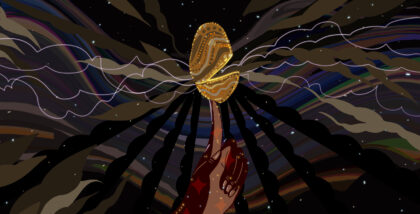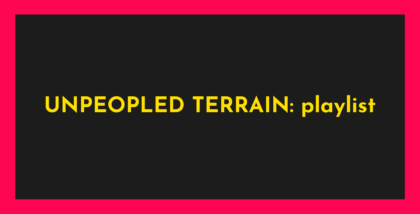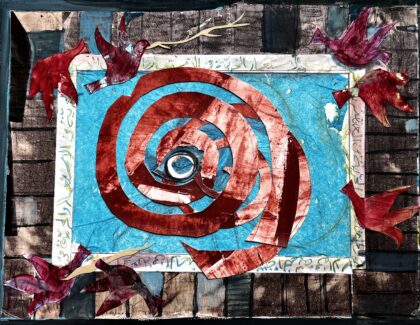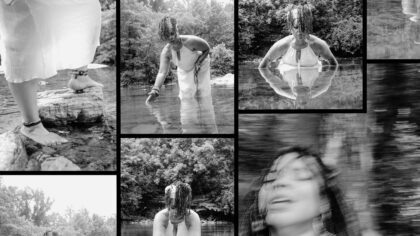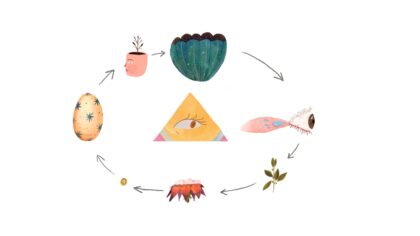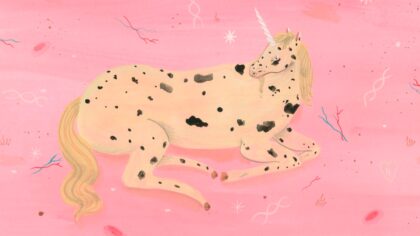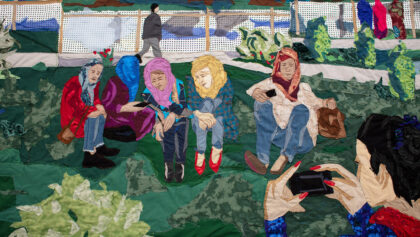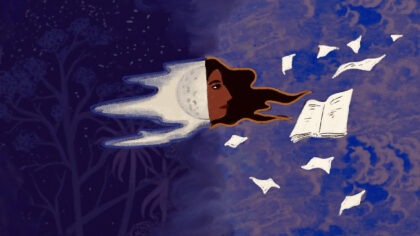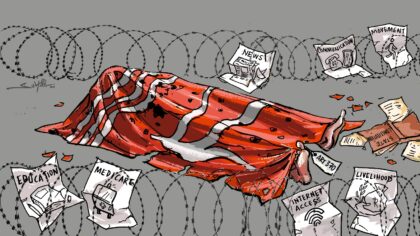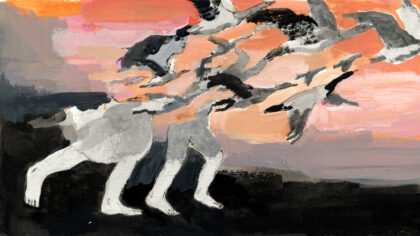 A still from asinnajaq’s 2017 film, Three Thousand. Image courtesy of the artist and the National Film Board of Canada.
A still from asinnajaq’s 2017 film, Three Thousand. Image courtesy of the artist and the National Film Board of Canada.
The floor of the Arctic forests in Nunavik are carpeted with lichens, composite organisms made of algae, fungi, and sometimes cyanobacteria. Deeply symbiotic, lichens express themselves through their relationships with other life forms and landscapes, emerging in unique shapes, colors, and textures—some plant-like, others mossy. Among the oldest living organisms on the planet, their extreme sensitivity to shifts in environmental conditions and resilient growth patterns mean they’re apt chroniclers of the passage of time.
A cluster of lichens threads the past, present, and future in Inuk artist asinnajaq’s 2017 film, Three Thousand. Combining archival footage of Inuit life from the National Film Board of Canada with original animation, asinnajaq distorts linear time to weave new possibilities for her people, creating a loop between the conditions of the past and inventiveness of the future. We see images of mothers deftly carving salmon contrasted with Inuit children being force-fed the English alphabet at a residential school; elsewhere, an Arctic hare feasting on dry grass. While these scenes suggest fissures in ancestral knowledge over colonial interventions, asinnajaq does not abandon the Inuit faces and gestures of her film—they are instead invited to a realm of her making.
Born in Kuujjuaq, Nunavik, and raised in Montreal, asinnajaq’s access to university education depended on the construction of a hydro dam on her homeland—a condition of the 1975 James Bay and Northern Quebec Agreement. She is acutely aware of how expropriation and extraction of resources entrap the future, yet she refuses to accept these conditions as fixed. Her work, often rendered through video and installation, combines performance and natural cycles to inspire alternative modes of living. The worlds she imagines in her art are not unrecognizable but instead depend on environmental wisdom, like a recent project exploring the tension and submission of a river as a model for relating to nature. “Time looping around connects me moment to moment with the past and future of the legacy of what it means to be Inuit,” she says.
As part of the curatorial team for the Canadian Pavilion at the 2019 Venice Biennale and one of four curators who worked on the inaugural exhibition of the new museum, Qaumajuq, in Winnipeg in 2020, asinnajaq’s work is deeply embedded in research and collaboration with other Inuit artists. Our conversation traversed the notion of the Arctic as “empty,” climate action as akin to breathing, and the contradictions of political recognition on stolen land.
Brannavy Jeyasundaram: What are the sounds, sights, and textures of your upbringing in Nunavik?
asinnajaq: I was a baby in Kuujjuaq, where I was born, near Ungava Bay. I remember being in the pocket of the amauti on my mother’s back. And I remember her lifting up the hood and shielding me from the wind, and feeling grumpy because it got so dark and hot inside, and I wanted to see the world. That’s one of my first memories. We would go camping, and eat lots of beautiful food on the land, when I was very young. When I was four years old, we moved to the city, so for the majority of my childhood, I was in the suburbs of Montreal. And that was very different, but lots of tree climbing, and running in the grass, and always with my grandmother and my mother planting in gardens. I still love looking at all the bugs you find when you are planting in the soil. That’s one of my favorite things about gardening.
Brannavy Jeyasundaram: Can you describe your path towards art making? What draws you to this form of intervention?
asinnajaq: I always enjoyed trying to get something from my head, out of my head. Or just seeing what my hands could make. And then at some point, when I was towards the end of high school, I started to get really interested in communication. I thought about what is worth communicating and what I know that should be communicated. I also loved reading so much, I loved being in stories and learning from authors. So when I went to university and studied film, I enjoyed the same quality in movies. What I really loved was when a work was beautiful and interesting but also left me a changed person; that is, it offered me something I could carry forward in my life. I really wanted to learn and contribute what I could to other people’s thinking and growing, to everyone that is on a journey of learning in the world.
Brannavy Jeyasundaram: Your work is situated in Northern landscapes, the environment that is often used to visualize the climate crisis, through melting ice caps and starving polar bears. What does this imagery provoke in you? Does it affect your artistic practice?
asinnajaq: It doesn’t affect me too much. I have had the opportunity to travel the world and share my work, and it is in these settings that people often expect or want something different from my artwork. That it should talk more about what they see as the destruction of my homeland always makes me sad, not for myself but for people who think that our homeland isn’t a part of this world and that it’s not also their home. Whatever is happening, whatever signals that we see of a changing landscape anywhere in the world, affect one another. The world is all connected. The water from Greenland flows to and from and around the world.
Heavy metals from cities deposit themselves on my homeland and affect my family and the animals that we are in relation with. All of our actions somehow affect each other. My breath now will travel around the whole world. It’s not stagnant. That is what I feel when I hear people acting as if it’s my problem. It’s not my problem, it’s everyone’s problem.
Brannavy Jeyasundaram: Yes, the interconnectivity of the earth’s systems seems to get lost in the popular apocalyptic framing of the climate crisis. Similarly, you’ve spoken before about the preconception of the Arctic as an empty, barren place—an idea you wish to counter with the notion of the Arctic being “full.”
asinnajaq: What purpose does the dominant belief, for example, that the Arctic land is empty, serve? It seems to me like it’s only so that the land can be easily taken away. You can take something away if you tell masses of people that it has no value. But it’s not true. So many people are missing out on such a beautiful place by thinking there is nothing when there is so much. Beautiful flora, beautiful lichen. Just so many things that give us the tools that we need to survive.
As Inuit, we are very smart and inventive to figure out a way to live on our homeland, but at the same time, it’s not like we are not people. At the end of the day, if the land doesn’t provide what we need then we can’t live there. As a track record, being able to sustain ourselves on our homeland for thousands of years says everything you need to know about what we have on those lands. It has everything you need to live a beautiful life. Sometimes hard, definitely, but also beautiful.
Brannavy Jeyasundaram: Lichen forms a portal between past, present, and future in your 2017 film, Three Thousand, which combines archival footage to produce counter images of Inuit survival, kinship, and ingenuity. How do you consider the nature of time in your work?
asinnajaq: We have memories and legacies that we have received and will give back. We have sustained actions throughout centuries that will repeat when we continue our relationships with environments like campgrounds and places for fishing or anything like that. I think that when we sustain these relationships over time it makes time loop around. And that time looping around connects me moment to moment with the past and future of the legacy of what it means to be Inuit. I try to treat time as simply as possible and always have the possibility for that loop around in it.
Brannavy Jeyasundaram: There’s a circularity throughout the film, where there is no clear distinction between what is considered from a certain time period versus another.
asinnajaq: Yes, the whole film is also made to be an installation so it loops around and kind of erases the beginning. One of the things that happens to it when it’s viewed as a cycle is that there is a question of what progress means. What does it mean to change and what could the future be? When it’s viewed as a film, beginning to end, then it ends in the future. But when it’s viewed as a cycle, I think the question is, is the future we are looking towards more like how we have lived in the past? When thinking about sustainability and treading lightly on the earth, we already have such great examples of how to do it and sure maybe it takes all of your time, but why not spend my time with my family cooking and sewing and doing things that I love doing?
Brannavy Jeyasundaram: How might a notion of time as cyclical and immemorial help us understand climate change?
asinnajaq: It’s so important for me to assert and reassert that we make decisions about what happens in our worlds. When it comes to conversations about loss, for example—losing a culture or losing glaciers—we are not losing them. People make decisions that put other things in peril. It’s not appropriate to talk about decisions people have made and call it loss. It’s not just slipping away. Decisions were made that put my culture at risk, our own decisions and mostly outside people’s decisions. It put us in a place where the world changed really fast and our way of being started not really looking like us.
Brannavy Jeyasundaram: The exploitation and extraction of land is very much tied to our social relationships, too. What do you think about the relationship between colonialism and environmental degradation impacting Inuit people?
asinnajaq: I’m just thinking about Nunatsiavut right now. People said, if we continue mining and this new hydro project (a hydroelectric dam sanctioned by the Government of Newfoundland and Labrador in 2012 was built in Nunatsiavut against the wishes of the Inuit), the George River caribou herd, which also goes through my homeland, won’t come back. And now it’s a devastated caribou herd. People can’t hunt caribou anymore. If that is a part of who you are, if you are in relation with animals, they become a part of your identity and so losing that relationship is a big loss in your life.
It’s so difficult because in one way, because of a hydro dam, I got to go to university. I didn’t have to work a job while I did it, I got to focus on my studies and make that a priority because we agreed to have a hydro dam.
When it comes to extraction, some people have jobs and you don’t want to make anyone feel bad for doing what they can figure out how to do to support their family. But then it’s like thinking about what our whole world looks like right now and thinking about wanting to have something beautiful for our great grandchildren. It’s a lot of impossible questions with the answer being kind of like, change everything.
Brannavy Jeyasundaram: You’re pointing to the way the manipulation of land and resource extraction corresponds to social benefits for Indigenous communities in Canada.
asinnajaq: It also goes back to our conversation about this notion of a barren land and what service that phrase pays. What does it do for colonial entities? It’s insane that the Arctic is barren only because it has things that they want to take from it. And in taking those things it changes our relationship with our land.
When I worked on a cruise ship, there was one stop near Nanisivik, a gas refilling station where tons of cargo ships go through, and I stepped out on the soil in this land and it was the most heartbreaking thing I have ever experienced in my whole life. I didn’t feel any soil. When I step off the plane to my hometown knowing that my family is there and I smell in the air, it is the calmest I could ever be. And stepping off the boat onto that gas refilling station was the most wrong thing that I ever felt in my whole life. It was deeply, deeply unsettling.
Brannavy Jeyasundaram: Following the recent publication of the UN Intergovernmental Panel on Climate Change’s report, the Inuit Circumpolar Council called for the greater incorporation of Inuit knowledge into national and international climate responses. Do you believe this call to be worthwhile? What do you think this requires from governing bodies?
asinnajaq: In my experience, solving problems first requires listening ears, and second, perspective and input. When it comes to climate change and emergencies, listening to lots of people who really care about and know their own lands is imperative. What’s valuable about Inuit knowledge is that there is collectively a great understanding of what the land has, what’s normal change and what’s not normal change. Over thousands of years, we learned the best way to operate on our land so that we can feel happy and comfortable with the way we are treating each other and the land. I always want to be as good as I can be and I think that was the same for my ancestors. So, thousands of years of people paying attention and learning and trying to be their best selves, that’s very strong knowledge.
Brannavy Jeyasundaram: You were one of four curators working on the inaugural exhibition of the new Inuit art center in Winnipeg. What was it like working in collectivity and what was your intention for the exhibit?
asinnajaq: It’s a very exciting and beautiful thing to have somewhere that will be a home for our artwork and to share our perspective with the world. This first exhibition, INUA, means a lot to me because I worked with my esteemed colleagues who are so smart and gentle. I worked with people who care so much about what it means to be Inuk and how we move forward together in this world. We really tried our best to unite Inuit artists through time whose work we have access to, thinking about what we want to carry forward with us from the past and what we want to leave behind. And also making sure that we don’t leave people who have historically maybe been left behind and do not deserve it.
Brannavy Jeyasundaram: What else are you working on these days?
asinnajaq: I just finished installing an artwork at the Plug In ICA in Winnipeg, a performance video called Raukokore. And a piece that I made last year for the Aumaaggiivik Nunavik art secretariat is for the first time being shown off of the computer and in the gallery. It’s in a new installation that is called Cradling River Piece, and it has flowing fabric, water onto a bed of cranberries, and then the video floating above it, above the water. In the performance video I let the current take me and then I walk against it.
I think about the meaning of the words resisting and submitting and how sometimes you could think it’s a bad thing to submit to something, like too much candy or whatever it is. And at the same time you can resist something that is good for you, too. I was talking with a friend and saying everything is submitting and resisting. Thinking about those words and what they mean in relation to operating in the world is really helpful for us to think about.
And the other thing that I’m doing right now is working for the first time on a VR project with the National Film Board and Parks Canada. I am making a work about one of the most beautiful places that I have ever been, the Torngat Mountains National Park which is in Nunatsiavut, right next to Nunavik, on the land that we really share together.
Brannavy Jeyasundaram: In the animated future portrayed in Three Thousand, the homes retain their iglu structure but are technologically interconnected. What else do you imagine for the future of Nunavik?
asinnajaq: The biggest thing that I imagine when I think about that future is really that we have our future in our hands and it’s not in anyone else’s hands. And then the other thing that I think about is: as Inuit, we are who we are because of our tools. And I think we really value ingenuity. You want to do something, maybe not in the fastest way, but the most efficient. You want to be cautious about your energy because you have so many things to do.
There are things in the natural world that are very useful to us that we will want to have, but not necessarily all of this technology that we create here. So when I think about the future, I imagine: what if we took what was always very useful for us, and if we only took a few things from this world right here? If we only take a few things, what will we take, what is useful? It’s very useful to have the radio, like we love having the radio on at home when I am in Inukjuak. It’s a beautiful way people stay connected so there are things that naturally become a part of us and our culture. And maybe there are some things we don’t need. So when I imagine the future, what I’m imagining is: how do we take these tools and make them our own and put a little bit of us, put a little bit of a computer and see what it would look like. I don’t imagine that I would want to completely move back in time but I want to be selective and careful and I want to make a beautiful life. There is a much more beautiful marriage that can be made of knowledge from around the world and our culture.
Watch the entirety of assinajaq’s film, Three Thousand, below.





